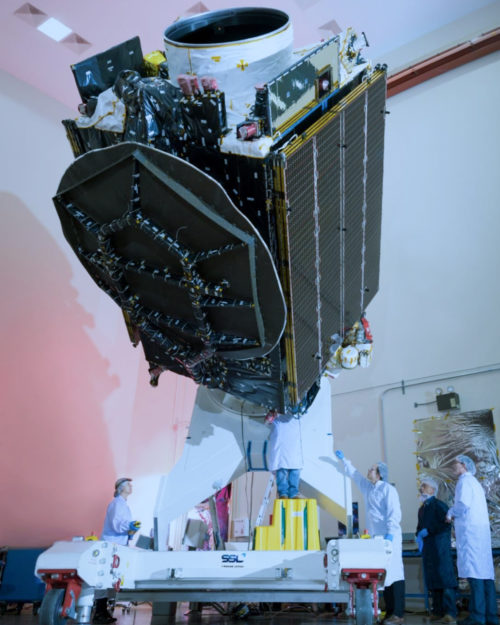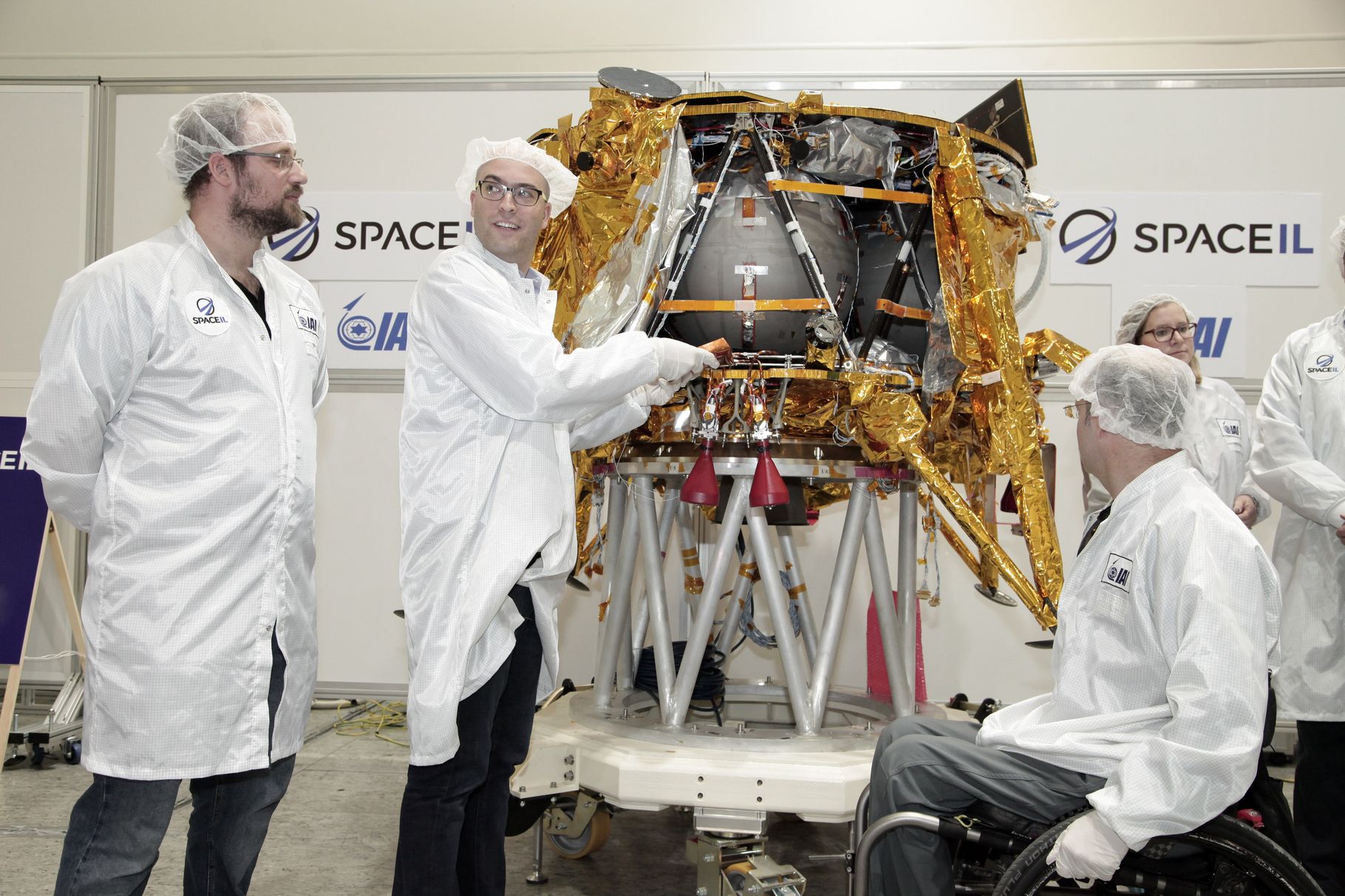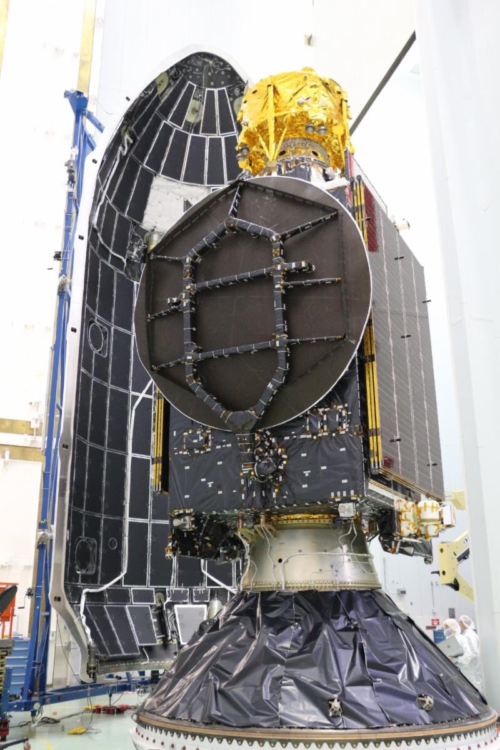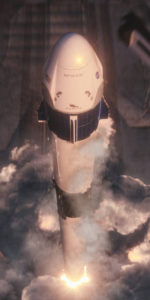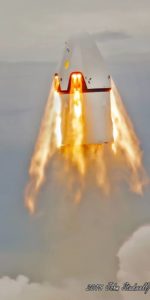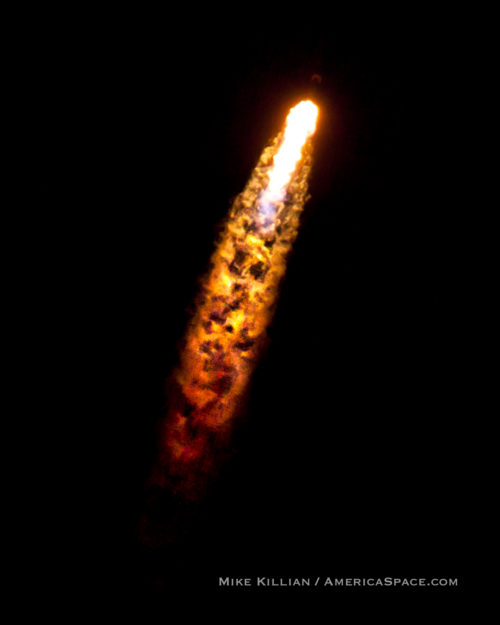
After two months of relative calm, a late-night dawn rose above Space Launch Complex (SLC)-40 at Cape Canaveral Air Force Station, Fla., when SpaceX’s second three-times-used Upgraded Falcon 9 booster—designated “B1048”—roared aloft at 8:45 p.m. EST Thursday, 21 February, laden with a powerful Indonesian communications satellite and a pair of rideshare customers, including an Israeli lunar lander and an experimental Air Force payload.
Tonight’s flight ends a six-week hiatus of SpaceX launches and the Hawthorne, Calif.-headquartered launch services organization’s second flight of 2019, following the completion of the Iridium NEXT constellation back in January. Looking ahead, attention turns to historic Pad 39A at the Kennedy Space Center (KSC), where the unpiloted test flight of the first Crew Dragon to the International Space Station (ISS) is currently set for a 2 March launch.
An Upgraded Falcon 9 core has previously been flown on three occasions. SpaceX’s very first Block 5, B1046, was utilized in May, August and December 2018 to deliver Bangladesh’s Bangabandhu-1 and Indonesia’s Merah Putih communications satellites to Geostationary Transfer Orbit (GTO), together with the record-breaking 64-satellite SSO-A Smallsat Express into Sun-synchronous orbit.
Tonight’s mission by B1048 sees the return of a first-stage core which previously lofted ten Iridium NEXT global mobile communications satellites in July 2018 and the heavyweight SAOCOM-1A Earth-observation payload for Argentina, last October. The Block 5 is characterized by uprated thrust on its Merlin 1D+ engines, strengthened landing legs, enhanced flight control systems and the capability to withstand an intensified heating regime as it returns from higher-energy GTO-bound launches.
Since May 2018, six Block 5 boosters have flown, of which two have now launched on three separate occasions, another pair on two occasions, and two others just once apiece so far. Tonight’s vehicle, B1048, first saw service in July 2018, when it delivered the seventh group of ten Iridium NEXT birds to low-Earth orbit. It flew again last October to boost Argentina’s SAOCOM-1A Earth observation satellite to space.
Primary payload for tonight’s mission was the 9,000-pound (4,100-kilogram) PSN-6 satellite, otherwise known as “Nusantara Satu”—Indonesian for “one archipelago”, indicative of the fact that its baseline 15-year mission will bring voice and data communications capability, together with broadband internet and video distribution services to the entire Indonesian archipelago. It will provide a vital link to Indonesia’s remote islands and villages to access emergency services, education and other benefits. The satellite has been fabricated by Space Systems/Loral (SS/L), on the bones of its tried-and-true SSL-1300 “bus”, which can provide total power ranges from 5-12 kilowatts and accommodation for up to 70 active C-band and Ku-band transponders.
Originally envisaged as a Boeing-built payload, a requisite co-passenger apparently could not be found with the mandated timeframe, and in late 2014 Indonesian satellite operator PT Pasifik Satelit Nusantara (PSN) signed with SS/L instead. “PSN has a charter to use satellites to provide innovative communications solutions that help improve lives and support economic growth in remote regions,” said SS/L President John Celli at the time. “We are very glad to have the opportunity to help PSN further this endeavour by providing not just a satellite, but a package of services to support its business goals, including launch.” As part of its contract, SS/L negotiated launch services through SpaceX.
In mid-2015, Space News reported that a “companion payload” would join PSN-6, which was then tracking a launch date sometime in 2017. Although unnamed at the time, it was stressed that the co-passenger was a U.S. Government payload to be released alongside PSN-6 “just above the geostationary arc”, some 22,370 miles (36,000 km) above the equator. “The cost of the launch to SS/L,” Space News noted, “was apparently low enough that it could integrate it into its offer and win the PSN business with or without a co-passenger.”
More recently, additional detail has emerged. The geostationary co-passenger, known by the rather drab designator of “S5”, is a 130-pound (60-kilogram) Air Force Research Laboratory (AFRL) payload for space situational awareness activities. Contracts for S5 were signed between AFRL and Blue Canyon Technologies, Inc., of Boulder, Colo., back in September 2017. It was noted that the S5 microsat would “measure the feasibility and affordability of developing low-cost constellations for routine and frequent updates to the GEO space catalog”—in essence, detecting, locating and inspecting other objects at geostationary altitude—and that it includes “ultra-precise attitude-control systems that allow for accurate knowledge and fine-pointing of the satellite payloads”. Applied Defense Systems built the S5 payload.
Perhaps more visually significant on this mission, though, was the presence of the 1,290-pound (585-kilogram) Beresheet (“Genesis”) lunar lander, developed by Israel’s SpaceIL organization, which was originally conceived as a competitor for the $30 million Google Lunar X-Prize. Five international teams competed for the prize, which ultimately went unclaimed, but remains active through the Lunar X-Prize as a non-cash competition.
SpaceIL’s lander was originally named “Sparrow” and would have fulfilled the Google Lunar X-Prize requirement of traversing up to 1,600 feet (500 meters) across the Moon’s surface by a unique rocket-propelled “hopping” mechanism. Equipped with a magnetometer and retroreflector array, it is expected that Beresheet—which represents Israel’s first foray beyond low-Earth orbit, as well as the lightest spacecraft ever to land on the Moon and the first privately-funded lunar lander—will survive for a couple of days on the surface.
At a cost of about $90 million, only $2 million comes from the government of Israel, most of the rest was donated by entrepreneur Morris Kahn and a Los Angeles charity supporting Israel called the Adelson Family Foundation.
Only the U.S. Russia and China – governments – have ever launched anything to and successfully landed on the moon.
And the little 1,300 pound lunar lander will be the first to deploy of the three payloads after launch, sitting at the top of the stack, and will fly a series of orbits – each wider and wider – until it intercepts the moon and enters lunar orbit in early April. A landing would follow about a week later, in a region named Mare Serenitatis.
Both S5 and Beresheet are managed aboard this mission by Seattle, Wash.-based Spaceflight Industries, Inc., which organizes “rideshares” for secondary payloads via a range of launch vehicles, including Russia’s Dnepr and Soyuz, Northrop Grumman’s Antares and SpaceX’s Upgraded Falcon 9.
Last fall, the organization completed its first-ever purchase of an entire SpaceX rocket to deliver 64 satellites into orbit on its SSO-A Smallsat Express. However, whereas that multitude of payloads traveled to low-Earth orbit, tonight’s mission marks a milestone by going far beyond: delivering S-5 to GTO and Beresheet towards the Moon.
“This is an important mission for Spaceflight as we expand and evolve our customer offerings,” said Curt Blake, CEO of Spaceflight Industries, Inc. “The launches we pursue continue to get more sophisticated and demonstrate that our expertise goes beyond identifying and scheduling launches. We also offer valuable integration and deployment services that enable our customers to reach space in a cost-effective manner and get to their desired orbit successfully. With this mission, Spaceflight is demonstrating that the Moon is in reach.”
In December 2018, the PSN-6 communications satellite arrived at Cape Canaveral for pre-launch processing, fueling and integration. Last week, in readiness for an oceanic landing attempt for the mission, the East Coast-based Autonomous Spaceport Drone Ship (ASDS)—nicknamed “Of Course I Still Love You”—was drawn out to sea by the Signet Warhorse III tug, bound for a position about 410 miles (660 km) downrange in the Atlantic Ocean. And late on 18 February, the nine Merlin 1D+ engines of B1048’s core ignited on SLC-40 for the now-customary Static Fire Test.
With this major pre-launch milestone completed, SpaceX returned the booster to the Horizontal Integration Facility (HIF), where the payloads were installed, ready for flight.
Meteorological conditions for the primary (Thursday) and backup (Friday) launch attempts were predicted to be highly favorable, with only a 20-percent likelihood of a weather-related scrub, and as predicted – the weather cooperated beautifully.
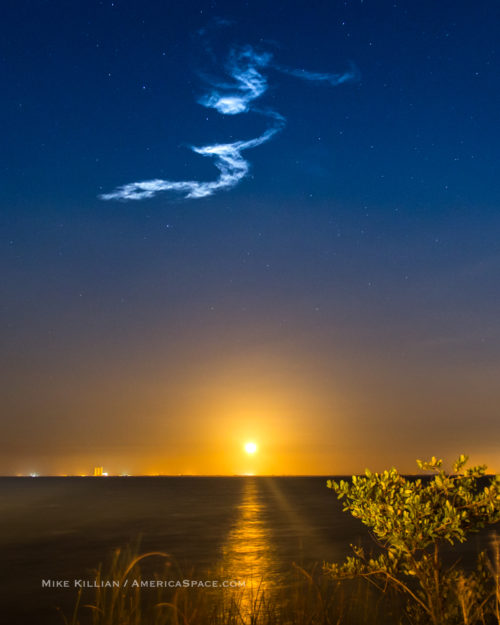
Launch was exceptionally smooth and, a few minutes later, for the 22nd time in less than three years, a returning Falcon 9 first stage plunged back to Earth and alighted smoothly on the deck of the drone ship.
Meanwhile, the second stage continued onward, under the thrust of its single Merlin 1D+ Vacuum engine, separating Beresheet at GTO via a custom separation system at T+33 minutes and 39 seconds. This would begin the Israeli lander’s multi-week effort to depart Earth’s gravitational influence and head for the Moon, which it is expected to reach in early April.
The Air Force’s S5, however, remained attached to the launch vehicle for another 11 minutes, until PSN-6 achieved its deployment altitude, whereupon it was separated.
.
.
FOLLOW AmericaSpace on Facebook and Twitter!
.
.




